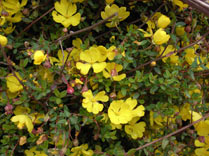In Flower This Week
A weekly news sheet prepared by a Gardens' volunteer.
Numbers before each plant refer to temporary IFTW labels in the gardens.
Numbers in square brackets [ ] refer to garden bed Sections. Plants in flower are in bold type.
View past issues of 'In Flower This Week'.
4 October 2013
Hibbertia empetrifolia click for larger image |
Springtime flowers, especially along Banks Walk, are so colourful, as are the orchids edging the Rainforest Gully. However areas further afield are also a joy to view. This walk will lead you past several boronias in many shades of pink. To arrive at the beginning, select any path or follow that marked on the reverse map.
- In front of the large bottle tree, Brachychiton rupestris [Section 42], with its large swollen trunk is Tetratheca pilosa subsp. latifolia. It is a low spreading plant with branches clad with pink cup-shaped flowers falling over the wall.
- At the upper corner Hibbertia empetrifolia [Section 42] is a dense plant dotted with bright yellow open flowers.
- Take the path to Section 39 where most plants are clad with white flowers, including the large shrub Philotheca myoporoides.
- The bed in the adjacent corner is clad with Kennedia retrorsa [Section 47], a vine with burnt orange pea-shaped flowers. It covers the ground and climbs the nearby shrubs.
- Beside is Eutaxia cuneata [Section 47], a medium many-branched shrub bearing small red-centred orange pea-shaped flowers.
- A corner of small Asterolasia buckinghamii plants [Section 46] are clad with yellow flowers
- In front Boronia ‘Aussie Rose’ [Section 46] is a small many-branched shrub clad with bright pink flowers.
- At the next bend a wattle, Acacia pycnostachya [Section 46], leaning towards the path, is a picture with its coverage of yellow fluffy flower rods.
- Crowded by other shrubs, the long branches of Boronia anemonifolia var. variabilis [Section 46] are clad with white flowers with just a touch of pink.
- Phebalium woombye [Section 46] is a large dense shrub clad with white flowers and prominent tan-coloured buds.
- Boronia muelleri ‘Sunset Serenade’ [Section 46] has pale pink, almost white, flowers covering the compact shrub.
- Further along, Boronia sp. aff. deanei [Section 46] is an erect shrub bearing bright pink open flowers.
- Phebalium whitei [Section 46] is a low open plant bright with yellow flowers.
- Close by Diplolaena microcephala [Section 46] is a medium, dense, spreading shrub with interesting downturned pinkish flower heads and many lemon stamens.
- Behind is Boronia ‘Telopea Valley Star’ [Section 46] with rich pink flowers.
- Grevillea johnsonii [Section 56] is an ageing plant with wandering branches around a large tree trunk. It has long fine leaves and lovely waxy curvaceous red-lemon flowers.
- Boronia ‘Tyalge Ruby’ [Section 56] is close by, with pale pink flowers on the compact shrub.
- A hybrid waratah, Telopea mongaensis x oreades [Section 56], is prominent with its many dusky red flower heads.
- About the top of this path, around the seat, are plants including Hakea lissocarpha [Section 56], with long branches clad with white feathery flowers.
- Grevillea montis-cole subsp. montis-cole [Section 56] is a low spreading shrub with small sharp foliage and bright red short toothbrush-like flowers.
- Around the corner and not to be missed is Petrophile biloba [Section 56], a low open sparsely-branched shrub clad with yellow-speckled woolly greyish flowers.
There is no room to list the many plants worth viewing in this area..... a really magical place to enjoy.
Barbara Daly
![Director of National Parks [logo]](../../../../images/dnp_90px.gif)







